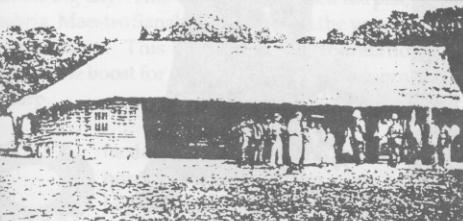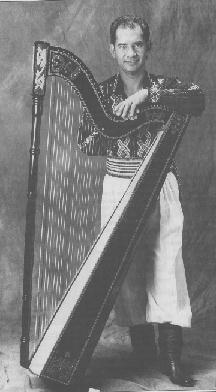
A traditional Paraguayan home with ramada
YHA has adapted this article from one entitled "Cesar Daniel Lopez - Harpist, composer, harp-builder" by Allegra Hardulfi. That article appeared in The Folk Harp Journal, No. 86, Winter 1994. We also spoke with Cesar Daniel on the phone, and he was kind enough to answer our questions and give us his thoughts. We hope you enjoy reading about how one boy who had no opportunities for learning the harp became a professional harpist by the time he was 17!
A hearty thank you to Allegra Hardulfi for allowing us to adapt her article!
A little about:
Cesar Daniel's family lived the way most farmers did in their region. Their home had two parts: a thatch-covered, semi-circular enclosure made of adobe that was the family's sleeping quarters, with a large ramada attached to it that provided shade where daily activities took place. Cesar Daniel did not go to school, but worked on the farm with the rest of his family.

A traditional Paraguayan home with ramada
A typical day went like this:
At dawn every family member set off to different parts of the farm for early chores. One person stayed behind to care for babies and young children, and to cook and clean. At about eight o'clock this person carried breakfast to the folks working around the farm. At midday, the family gathered under the ramada for dinner and to share an ancient herbal drink which was passed from one person to the next. After resting during the hottest part of the day the family worked until sunset. By nine in the evening everyone was asleep.
When Cesar Daniel was still very young, his brother Juan was drafted into military service. Juan loosened the strings of the guitar and hung the instrument high on the wall, and off he went. One day a guest picked up the guitar and, teasing, asked Cesar Daniel to tune the instrument. Cesar Daniel did so easily--much to the astonishment of his elders! After that, Cesar Daniel pestered his father to take the guitar off the wall and show him some chords. By the time Juan returned home, he had learned to play the guitar and to sing well enough to provide soprano voice at serenades and other occasions for which his father and Juan played. He was about seven years old.
Cesar Daniel heard the harp and was hooked. He had to play it!
But near his home there was no one who played the harp, no one who could teach him, and no harps anywhere. Still, he knew he must play one.
And so, Cesar Daniel, his father and his brother set out to build a harp. Cesar Daniel cajoled his mother into sacrificing a large gourd reserved for next year's seed stock. The gourd became the sound box for the harp. Next Cesar Daniel set out into the woods to find branches suitable for the harmonic curve and pillar. Also, he sought out a plant that big palm-like leaves. By cutting and peeling the outer skin of the plant he found strong fibers that were like the monofilament nylon strings of a harp. These fibers became the harp's treble strings. The bass strings were made of carefully cured and twisted strands of horse skin. Cesar Daniel tuned the harp to the white keys of his father's accordion, and began to teach himself to play.
Eventually the Lopez family acquired a crude, box-like harp that a neighbor had made. It was barely playable, but it was harp-shaped and had nylon strings, and offered more musical possibilities than the gourd harp. While in a city Juan noticed how harpists held their arms and shaped their fingers. He described what he saw to Cesar Daniel. This information provided enough clues to really get him going. Cesar Daniel took off transferring his singing repertoire and guitar experience to the harp. Soon he could play melody lines and basic harmonies.
An uncle who was a carpenter offered Cesar Daniel the loan of an old harp that someone had brought for repair and never picked up. Don Daniel Senior struck a deal with the uncle. In exchange for enough wood from his land to build a house, the carpenter would make a harp for young Daniel copied from the old harp. That instrument became an addition to the family's band, and people in the region began talking about the boy who played the harp. Another relative was home from the big city for a visit in a nearby village. He heard of Cesar Daniel and summoned him for teaching. The relative was a renowned harpist, Reuben Sanabria. Now Cesar Daniel had a solid foundation for playing the harp!

Reuben Sanabria gave Cesar Daniel a set of strings. Unfortunately, when Cesar Daniel put them on the harp, the harp broke! He had to take the harp back to his uncle to fix, and as Cesar Daniel told us: "Father had to pay him a lot!" --meaning that he had to provide a lot of work or goods in trade to fix it.
Also, once Cesar Daniel was to perform for a wedding party. He rode a horse three hours to get there. But on the way he dropped his tuning key! Someone knew of a man who had bought a harp for his son, but the son had never played it. He thought that this man might have a tuning key. Sure enough he did. The man offered to sell the harp and a guitar to Cesar Daniel. Sometime later, Cesar Daniel returned to check out the harp and guitar again, to make sure they were nice. He ended up trading his horse for the harp and the guitar! When his uncle refinished the harp, they discovered that it had been made in Asuncion, capitol of Paraguay. This was a real harp!